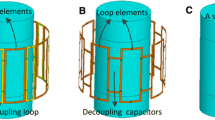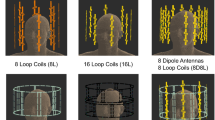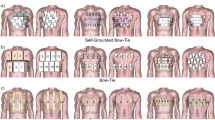Abstract
Objective
Accelerating the co-simulation method for the design of transmit array (TxArray) coils is studied using equivalent circuit models.
Materials and methods
Although the co-simulation method dramatically reduces the complexity of the design of TxArray coils, finding the optimum solution is not trivial since there exist many local minima in the optimization problem. We propose to utilize an equivalent circuit model of the TxArray coil to obtain a proper initial guess for the optimization process of the co-simulation method. To prove the concept, six different TxArray coils (i.e., three degenerate birdcage coils (DBC), two dual-row head coils, and one elliptical body TxArray coil) with two different loading strategies (cylindrical phantom and human head/body model) at 3 T field strength are investigated theoretically; as an example study, an eight-channel head-DBC is constructed using the obtained values.
Results
This approach accelerates the design process more than 20-fold for the coils that are investigated in this manuscript.
Conclusion
A fast and accurate method for tuning and decoupling of a TxArray coil can be achieved using its equivalent circuit model combined with the co-simulation method.









taken from a uniform phantom using the DBC. The sequence parameters are TR = 100 ms, TE = 12 ms, NEX = 1, 128 × 128, FOV = 20 cm, and slice thickness = 5 mm. d, e The standard deviation of B1+ on readout and phase encoding axes corresponding to both BC and DBC. Calculated mean standard deviations (in percentage) verify a good performance of the DBC
Similar content being viewed by others
References
Tropp J (2004) Image brightening in samples of high dielectric constant. J Magn Reson 167(1):12–24
Bernstein MA, Huston J, Ward HA (2006) Imaging artifacts at 3.0 T. J Magn Reson Imaging 24(4):735–746
Childs AS, Malik SJ, O’Regan DP, Hajnal JV (2013) Impact of number of channels on RF shimming at 3T. Magn Reson Mater Biol Phy Med 26(4):401–410
Setsompop K, Wald LL, Alagappan V, Gagoski B, Hebrank F, Fontius U, Schmitt F, Adalsteinsson E (2006) Parallel RF transmission with eight channels at 3 Tesla. Magn Reson Med 56(5):1163–1171
Guérin B, Gebhardt M, Cauley S, Adalsteinsson E, Wald LL (2014) Local specific absorption rate (SAR), global SAR, transmitter power, and excitation accuracy trade-offs in low flip-angle parallel transmit pulse design. Magn Reson Med 71(4):1446–1457
Cloos MA, Luong M, Ferrand G, Amadon A, Le Bihan D, Boulant N (2010) Local SAR reduction in parallel excitation based on channel-dependent Tikhonov parameters. J Magn Reson Imaging 32(5):1209–1216
Zhu Y, Alon L, Deniz CM, Brown R, Sodickson DK (2012) System and SAR characterization in parallel RF transmission. Magn Reson Med 67(5):1367–1378
van den Bergen B, Van den Berg CA, Bartels LW, Lagendijk JJ (2007) 7 T body MRI: B1 shimming with simultaneous SAR reduction. Phys Med Biol 52(17):5429
Guérin B, Gebhardt M, Serano P, Adalsteinsson E, Hamm M, Pfeuffer J, Nistler J, Wald LL (2015) Comparison of simulated parallel transmit body arrays at 3 T using excitation uniformity, global SAR, local SAR, and power efficiency metrics. Magn Reson Med 73(3):1137–1150
Lattanzi R, Sodickson DK, Grant AK, Zhu Y (2009) Electrodynamic constraints on homogeneity and radiofrequency power deposition in multiple coil excitations. Magn Reson Med 61(2):315–334
Sadeghi-Tarakameh A, Torrado-Carvajal A, Ariyurek C, Atalar E, Adriany G, Metzger G, Lagore R, DelaBarre L, Grant A, Van de Moortele P, Ugurbil K, Eryaman Y (2018) Optimizing the topography of transmit coils for SAR management. In: Proceeding of the 26th Joint Annual Meeting ISMRM-ESMRMB, Paris, France. p 0297
Sadeghi-Tarakameh A, DelaBarre L, Lagore RL, Torrado-Carvajal A, Wu X, Grant A, Adriany G, Metzger GJ, Van de Moortele PF, Ugurbil K, Atalar E, Eryaman Y (2020) In vivo human head MRI at 10.5 T: A radiofrequency safety study and preliminary imaging results. Magn Reson Med 84(1):484–496
Sadeghi-Tarakameh A, Wu X, Ulus F, Eryaman Y, Atalar E (2019) Ultimate Intrinsic Specific Absorption Rate Efficiency. In: Proceedings of the 27th Annual Meeting of ISMRM, Montreal, QC, Canada. p 4166
Katscher U, Börnert P (2006) Parallel RF transmission in MRI. NMR Biomed 19(3):393–400
Zhu Y (2004) Parallel excitation with an array of transmit coils. Magn Reson Med 51(4):775–784
Pauly J, Nishimura D, Macovski A (1989) A linear class of large-tip-angle selective excitation pulses. J Magn Reson 82(3):571–587
Hardy CJ, Cline HE (1989) Spatial localization in two dimensions using NMR designer pulses. J Magn Reson 82(3):647–654
Eryaman Y, Akin B, Atalar E (2011) Reduction of implant RF heating through modification of transmit coil electric field. Magn Reson Med 65(5):1305–1313
Eryaman Y, Guerin B, Akgun C, Herraiz JL, Martin A, Torrado-Carvajal A, Malpica N, Hernandez-Tamames JA, Schiavi E, Adalsteinsson E (2015) Parallel transmit pulse design for patients with deep brain stimulation implants. Magn Reson Med 73(5):1896–1903
Eryaman Y, Turk EA, Oto C, Algin O, Atalar E (2013) Reduction of the radiofrequency heating of metallic devices using a dual-drive birdcage coil. Magn Reson Med 69(3):845–852
Kazemivalipour E, Keil B, Vali A, Rajan S, Elahi B, Atalar E, Wald LL, Rosenow J, Pilitsis J, Golestanirad L (2019) Reconfigurable MRI technology for low-SAR imaging of deep brain stimulation at 3T: application in bilateral leads, fully-implanted systems, and surgically modified lead trajectories. NeuroImage 199:18–29
Golestanirad L, Kazemivalipour E, Keil B, Downs S, Kirsch J, Elahi B, Pilitsis J, Wald LL (2019) Reconfigurable MRI coil technology can substantially reduce RF heating of deep brain stimulation implants: first in-vitro study of RF heating reduction in bilateral DBS leads at 1.5 T. PLoS ONE 14:8
Lee RF, Hardy CJ, Sodickson DK, Bottomley PA (2004) Lumped-element planar strip array (LPSA) for parallel MRI. Magn Reson Med 51(1):172–183
Adriany G, de Moortele V, Wiesinger F, Moeller S, Strupp JP, Andersen P, Snyder C, Zhang X, Chen W, Pruessmann KP (2005) Transmit and receive transmission line arrays for 7 Tesla parallel imaging. Magn Reson Med 53(2):434–445
Roemer PB, Edelstein WA, Hayes CE, Souza SP, Mueller O (1990) The NMR phased array. Magn Reson Med 16(2):192–225
Wu B, Qu P, Wang C, Yuan J, Shen GX (2007) Interconnecting L/C components for decoupling and its application to low-field open MRI array. Conc Magn Reson Part B Magn Reson Eng 31(2):116–126
Raaijmakers AJE, Ipek O, Klomp DWJ, Possanzini C, Harvey PR, Lagendijk JJW, van Den Berg CAT (2011) Design of a radiative surface coil array element at 7 T: the single-side adapted dipole antenna. Magn Reson Med 66(5):1488–1497
Raaijmakers AJE, Italiaander M, Voogt IJ, Luijten PR, Hoogduin JM, Klomp DWJ, van Den Berg CAT (2016) The fractionated dipole antenna: a new antenna for body imaging at 7 T esla. Magn Reson Med 75(3):1366–1374
Steensma B, Andrade A, Klomp D, Van den Berg C, Luijten P, Raaijmakers (2016) A Body imaging at 7 Tesla with much lower SAR levels: an introduction of the Snake Antenna array. In: Proceedings of the 24th Annual Meeting of ISMRM, Singapore. p 0395
Ertürk MA, Wu X, Eryaman Y, Van de Moortele PF, Auerbach EJ, Lagore RL, DelaBarre L, Vaughan JT, Uğurbil K, Adriany G (2017) Toward imaging the body at 10.5 tesla. Magn Reson Med 77(1):434–443
Sadeghi-Tarakameh A, Adriany G, Metzger GJ, Lagore RL, Jungst S, DelaBarre L, Van de Moortele PF, Ugurbil K, Atalar E, Eryaman Y (2020) Improving radiofrequency power and specific absorption rate management with bumped transmit elements in ultra‐high field MRI. Magn Reson Med. https://doi.org/10.1002/mrm.28382
Sadeghi-Tarakameh A, Jungst S, Wu X, Lanagan M, Adriany G, Metzger GJ, Van de Moortele P-F, Ugurbil K, Atalar E, Eryaman Y (2019) A New Coil Element for Highly-Dense Transmit Arrays: An Introduction to Non-Uniform Dielectric Substrate (NODES) Antenna. In: Proceedings of the 27th Annual Meeting of ISMRM, Montreal, QC, Canada. p 0732
Sadeghi-Tarakameh A, Torrado-Carvajal A, Lagore RL, Moen S, Wu X, Adriany G, Metzger GJ, DelaBarre L, Ugurbil K, Atalar E, Eryaman Y (2019) Toward Human Head Imaging at 10.5 T Using an Eight-Channel Transmit/Receive Array of Bumped Fractionated Dipoles. In: Proceedings of the 27th Annual Meeting of ISMRM, Montreal, QC, Canada. p 0430
Alagappan V, Nistler J, Adalsteinsson E, Setsompop K, Fontius U, Zelinski A, Vester M, Wiggins GC, Hebrank F, Renz W (2007) Degenerate mode band-pass birdcage coil for accelerated parallel excitation. Magn Reson Med 57(6):1148–1158
Stara R, Tiberi G, Morsani F, Symms M, Fantacci ME, Marletta M, Zampa V, Pendse M, Retico A, Rutt BK (2017) A degenerate birdcage with integrated Tx/Rx switches and butler matrix for the human limbs at 7 T. Appl Magn Reson 48(3):307–326
Sadeghi-Tarakameh A, Kazemivalipour E, Demir T, Gundogdu U, Atalar E (2018) Accelerating the Co-Simulation Method for Fast Design of Transmit Array Coils: An Example Study on a Degenerate Birdcage Coil. In: Proceeding of the 26th Joint Annual Meeting ISMRM-ESMRMB, Paris, France. p 4404
Kazemivalipour E, Sadeghi Tarakameh A, Yilmaz U, Acikel V, Sen B, Atalar E (2018) A 12-channel degenerate birdcage body transmit array coil for 1.5T MRI scanners. In: Proceeding of the 26th Joint Annual Meeting ISMRM-ESMRMB, Paris, France. p 1708
Kozlov M, Turner R (2009) Fast MRI coil analysis based on 3-D electromagnetic and RF circuit co-simulation. J Magn Reson 200(1):147–152
Kozlov M, Turner R Analysis of RF transmit performance for a multi-row multi-channel MRI loop array at 300 and 400 MHz. In: Microwave Conference Proceedings (APMC), 2011 Asia-Pacific, 2011. IEEE, pp 1190–1193
Kozlov M, Turner R Analysis of RF transmit performance for a 7T dual row multichannel MRI loop array. In: Engineering in Medicine and Biology Society, EMBC, 2011 Annual International Conference of the IEEE, 2011. IEEE, pp 547–553
Cheng DK (1993) Fundamentals of engineering electromagnetics. Pearson Education, New Jersey, pp 136–142
Grover FW (2004) Inductance calculations: working formulas and tables. Dover Publication, New York, pp 20–76
Tarakameh AS (2016) Design of a birdcage-like radio frequency transmit array coil for the magnetic resonance imaging using equivalent circuit model. Bilkent University, Thesis
Jin J (1998) Electromagnetic analysis and design in magnetic resonance imaging, vol 1. CRC Press, Florida
Kozlov M, Turner R (2010) A comparison of Ansoft HFSS and CST microwave studio simulation software for multi-channel coil design and SAR estimation at 7T MRI. Piers Online 6(4):395–399
Pozar DM (2009) Microwave engineering, 2nd edn. John Wiley & Sons, New York, pp 182–244
Habashy TM, Abubakar A (2004) A general framework for constraint minimization for the inversion of electromagnetic measurements. Progr Electromagn Res 46:265–312
Etminan A, Sadeghi A, Gurel L (2014) Electromagnetic imaging of three-dimensional dielectric objects with Newton minimization. In: Antennas and Propagation Society International Symposium (APS-URSI), IEEE, p 876–877
Hayes CE, Eash MG (1987) Shield for decoupling RF and gradient coils in an NMR apparatus. Google Patents
Roemer PB, Edelstein WA (1989) RF shield for RF coil contained within gradient coils of NMR imaging device. Google Patents
Bahl IJ (2003) Lumped elements for RF and microwave circuits. Artech house, Boston
Hafalir FS, Oran OF, Gurler N, Ider YZ (2014) Convection-reaction equation based magnetic resonance electrical properties tomography (cr-MREPT). IEEE Trans Med Imaging 33(3):777–793
Gurler N, Ider YZ (2017) Gradient-based electrical conductivity imaging using MR phase. Magn Reson Med 77(1):137–150
Sacolick LI, Wiesinger F, Hancu I, Vogel MW (2010) B1 mapping by Bloch-Siegert shift. Magn Reson Med 63(5):1315–1322
Turk EA, Ider YZ, Ergun AS, Atalar E (2015) Approximate Fourier domain expression for Bloch-Siegert shift. Magn Reson Med 73(1):117–125
Acknowledgements
This project was supported by ASELSAN A.S. Ankara, Turkey. MREPT experiments were performed by the aid of Mr. Safa Ozdemir using the facilities of UMRAM, Bilkent University, Ankara, Turkey.
Author information
Authors and Affiliations
Contributions
AST: responsible for study conception and design, acquisition of data, analysis and interpretation of data, and drafting of manuscript. EK: involved in study conception and design. UG: advised and developed methods for the acquisition of data. SE: advised and developed methods to analyze the data. EA: responsible for study conception and design, analysis and interpretation of data, drafting of the manuscript, and critical revision of the manuscript.
Corresponding author
Ethics declarations
Conflict of interest
The authors declare that they have received a research grant from ASELSAN.
Ethical approval
The editorial does not contain any studies with human participants or animals performed by any of the authors.
Human and animal rights
This article does not contain any studies with human participants or animals performed by any of the authors.
Additional information
Publisher's Note
Springer Nature remains neutral with regard to jurisdictional claims in published maps and institutional affiliations.
Electronic supplementary material
Below is the link to the electronic supplementary material.
Rights and permissions
About this article
Cite this article
Sadeghi-Tarakameh, A., Kazemivalipour, E., Gundogdu, U. et al. Accelerating the co-simulation method for the design of transmit array coils for MRI. Magn Reson Mater Phy 34, 165–178 (2021). https://doi.org/10.1007/s10334-020-00858-0
Received:
Revised:
Accepted:
Published:
Issue Date:
DOI: https://doi.org/10.1007/s10334-020-00858-0




